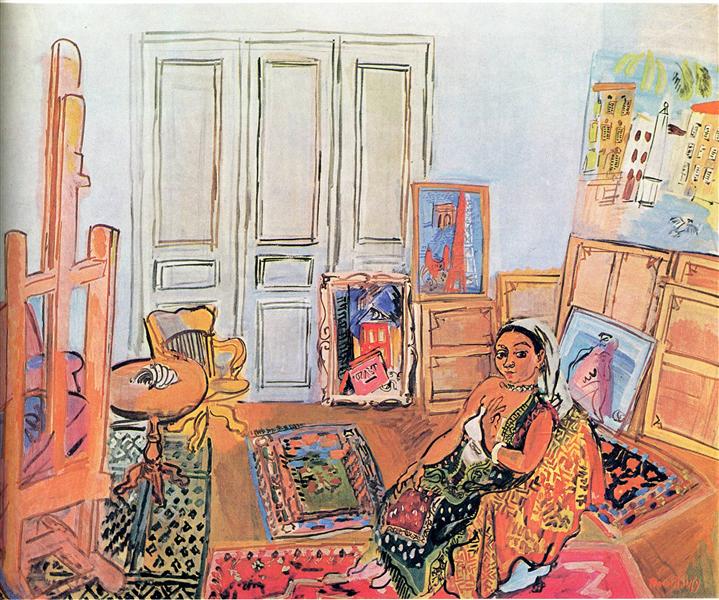Description
The painting "Indian model in the study of L'Passe Guelman" by Raoul Dufy, created in 1928, is a work that encapsulates the vibrant and experimental spirit of modern art at the beginning of the 20th century. Dufy, known for his innovative approach to color and shape, presents in this work a fusion of tradition and modernity, using its characteristic style that is often inscribed in the Fauvist movement. The painting reflects a personal interpretation of the indigenous model, leading it to a European context that invites reflection on the relationship between the exotic and the everyday.
In the composition of the work, an indigenous model occupies the center of the canvas, while the study environment unfolds around it with a dynamic sense of order. The figure of the model, with its colorful outfit, contrasts with the simple and almost austere atmosphere of the study. Dufy uses curved lines and fluid shapes that give the whole a sensation of movement and vitality. The use of perspective is notably free, which suggests a less rigid approach to spatial representation, emphasizing the emotional and sensory aspect of artistic creation.
Color is perhaps one of the most prominent aspects of this work. Dufy moves away from the gloomy palette and enters a world of bright and saturated colors, evoking both the light and the warmth of the environment. The nuances of blue, red, yellow and green are combined to create an atmosphere that is both cheerful and introspective. This chromatic choice not only highlights the figure of the model, but also becomes a vehicle to express the identity and culture it represents. The way Dufy uses color aligns with fauvistas ideas that color must be released from its descriptive function and become an expressive medium by itself.
In the background, the representation of the study is impregnated with details that, although subtle, are significant. The inclusion of decorative elements and artist tools suggests a dialogue between the artistic creation and the life of the model. Thus, Dufy not only portrays the indigenous model, but also proposes a space where culture and art converge. This interdisciplinary approach allows the viewer to consider the relationship between the artist, his subject and the environment in which they are found.
While "Indian model in the study of L'Passe Guelman" may not be as well known as other works of Dufy, its relevance lies in the way in which the ethos of an era of aesthetic and cultural exploration captures. Raoul Dufy, through this work, invites the viewer to a reflection on identity, cultural influences and artistic practice at a time when the world felt increasingly interconnected. This is manifested in the choice of its model and in the surrounding environment, pointing out the complex interrelations that exist between art, cultural identity and human experience.
In conclusion, Dufy's work is within a broader context of dialogue between civilizations and artistic traditions. This piece, although framed in its own time and space, continues to dialogue with the contemporary spectator, inspiring an appreciation for diversity and beauty in artistic expression. The technical mastery and the unique vision of Dufy consolidate it as one of the great exponents of modern art, and "Indian model in the study of L'Passe Guelman" is a testimony of its ability to transcend cultural barriers through art.
KUADROS ©, a famous paint on your wall.
Hand-made oil painting reproductions, with the quality of professional artists and the distinctive seal of KUADROS ©.
Art reproduction service with satisfaction guarantee. If you are not completely satisfied with the replica of your painting, we refund your money 100%.

